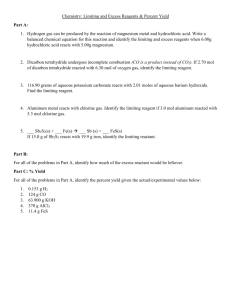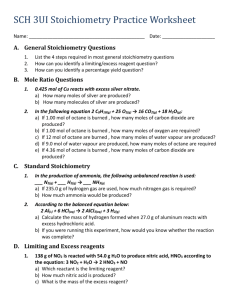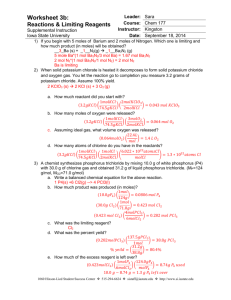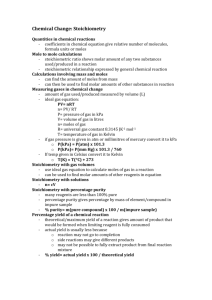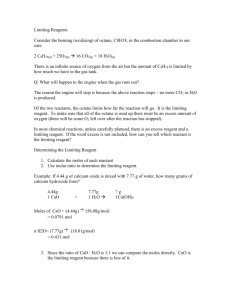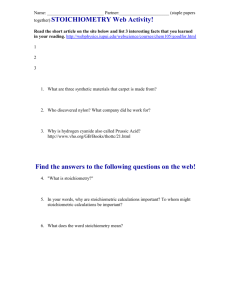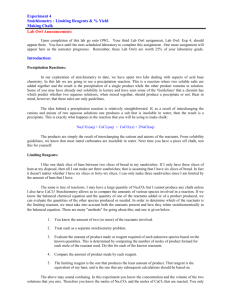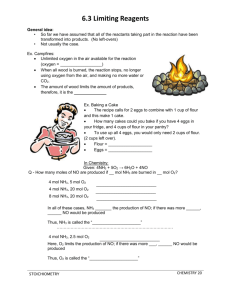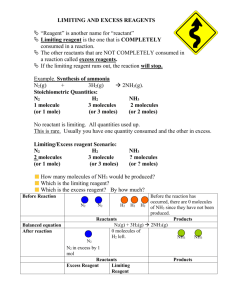Limiting Reagent - Reagent that limits the amount of
advertisement
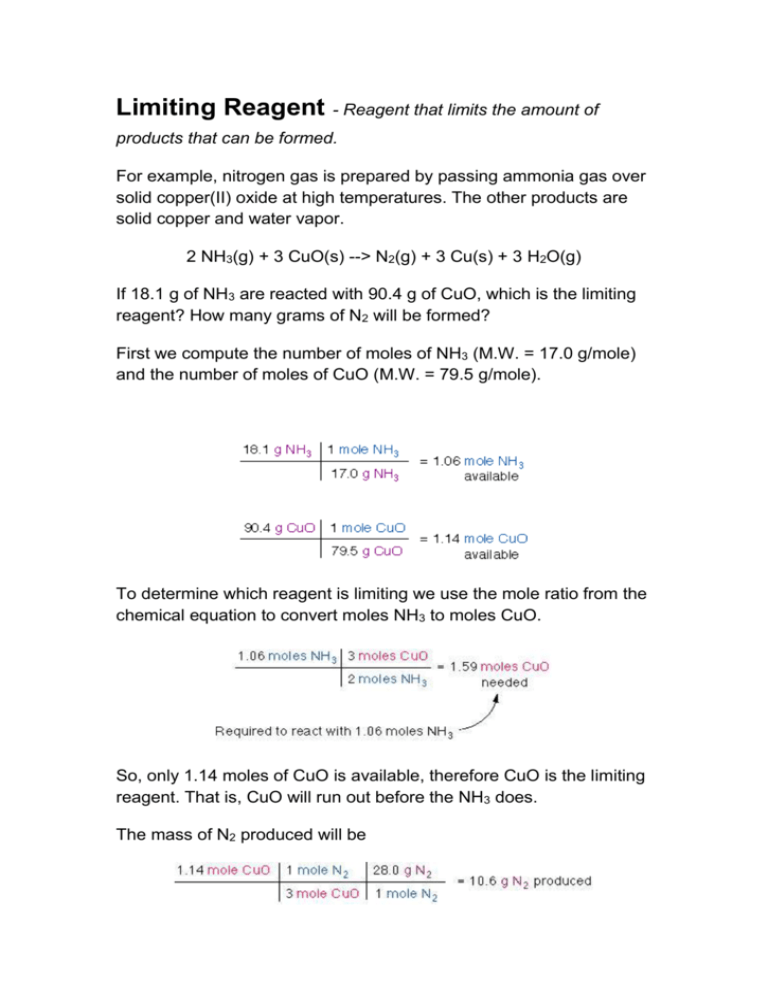
Limiting Reagent - Reagent that limits the amount of products that can be formed. For example, nitrogen gas is prepared by passing ammonia gas over solid copper(II) oxide at high temperatures. The other products are solid copper and water vapor. 2 NH3(g) + 3 CuO(s) --> N2(g) + 3 Cu(s) + 3 H2O(g) If 18.1 g of NH3 are reacted with 90.4 g of CuO, which is the limiting reagent? How many grams of N2 will be formed? First we compute the number of moles of NH3 (M.W. = 17.0 g/mole) and the number of moles of CuO (M.W. = 79.5 g/mole). To determine which reagent is limiting we use the mole ratio from the chemical equation to convert moles NH3 to moles CuO. So, only 1.14 moles of CuO is available, therefore CuO is the limiting reagent. That is, CuO will run out before the NH3 does. The mass of N2 produced will be Limiting Reactants Suppose you wish to make several sandwiches using one slice of cheese and two slices of bread for each sandwich. Using Bd bread, Ch cheese, and sandwich, the recipe for making a sandwich can be represented like a chemical equation: If you have 10 slices of bread and 7 slices of cheese, you will be able to make only five sandwiches before you run out of bread. You will have two slices of cheese left over. The amount of available bread limits the number of sandwiches. An analogous situation occurs in chemical reactions when one of the reactants is used up before the others. The reaction stops as soon as any one of the reactants is totally consumed, leaving the excess reactants as leftovers. Suppose, for example, that we have a mixture of 10 mol and 7 mol which we react to form water: Because 2 mol the number of moles of to react with all the Because 7 mol needed is was available at the start of the reaction, will still be present when all the is consumed. The example we have considered is depicted on a molecular level in Figure 3.15. Figure 3.15 Diagram showing the complete consumption of a limiting reagent in a reaction. Because the H2 is completely consumed, it is the limiting reagent in this case. Because there is a stoichiometric excess of O2 some is left over at the end of the reaction. Excess and Limiting Reagents Chemical reaction equations give the ideal stoichiometric relationship among reactants and products. However, the reactants for a reaction in an experiment are not necessarily a stoichiometric mixture. In a chemical reaction, reactants that are not use up when the reaction is finished are called excess reagents. The reagent that is completely used up or reacted is called the limiting reagent, because its quantity limit the amount of products formed. Let us consider the reaction between sodium and chlorine. The reaction can be represented by the equation: 2 Na + Cl2 = 2 NaCl, It represents a reaction of a metal and a diatomic gas chlorine. This balanced reaction equation indicates that two Na atoms would react with two Cl atoms or one Cl2 molecule. Thus, if you have 6 Na atoms, 3 Cl2 molecules will be required. If there is an excess number of Cl2 molecules, they will remain unreacted. We can also state that 6 moles of sodium will require 3 moles of Cl2 gas. If there are more than 3 moles of Cl2 gas, some will remain as an excess reagent, and the sodium is a limiting reagent. It limits the amount of the product that can be formed. Chemical reactions with stoichiometric amounts of reactants has no limiting or excess reagents. Example 1 Calculate the number of moles of CO2 formed in the combustion of ethane C2H6 in a process when 35.0 mol of O2 is consumed. Hint... The reaction is 2 C2H6 + 7 O2 = 4 CO2 + 6 H2O 4 mol CO2 35.0 mol O2 ---------- = 20.0 mol CO2 7 mol O2 Discussion... A balanced equation for the reaction is a basic requirement for identify the limiting reagent even if amounts of reactants are known.
